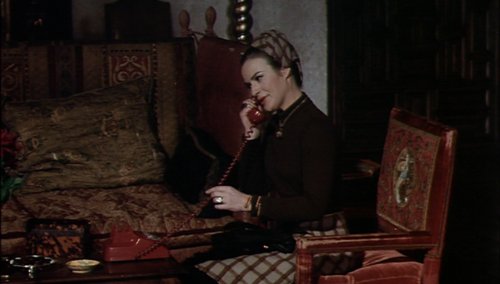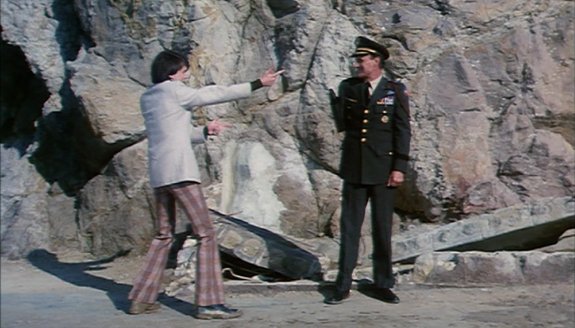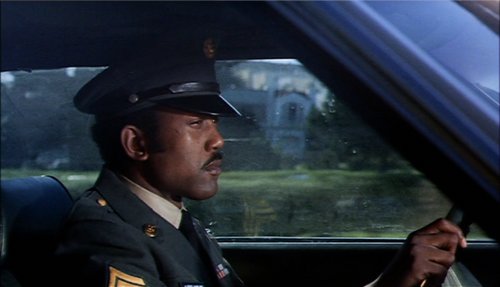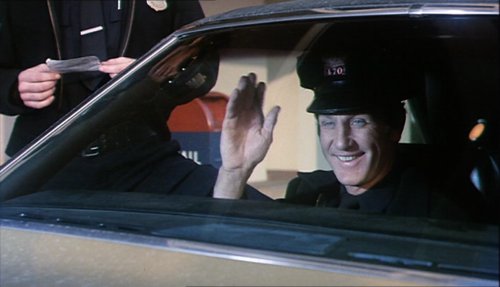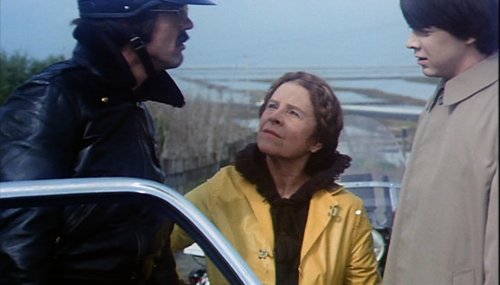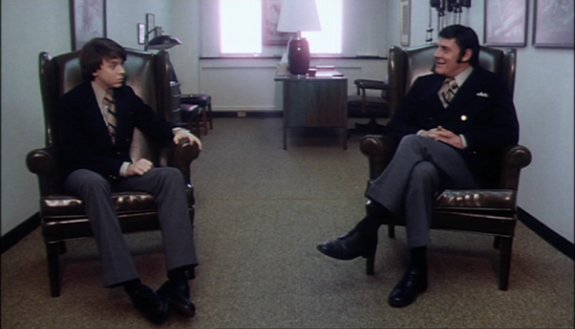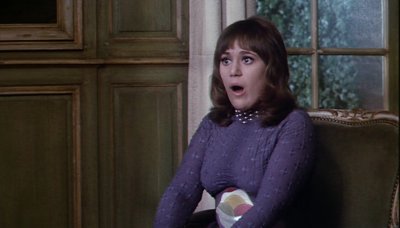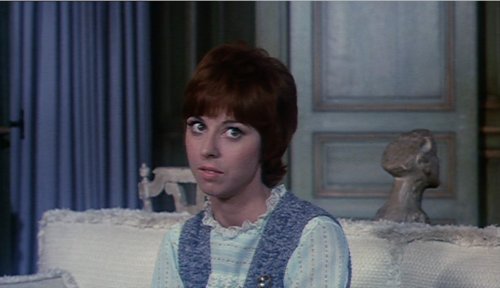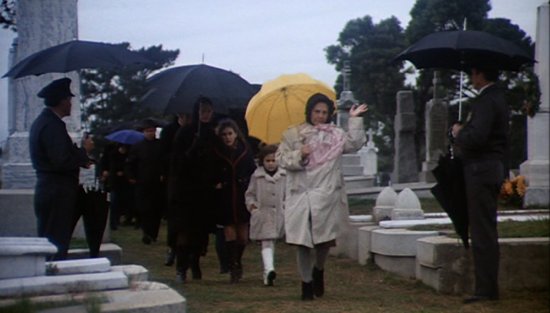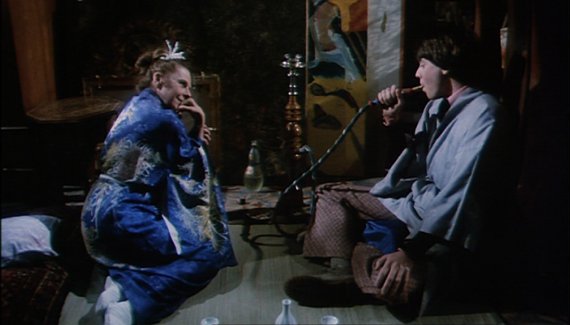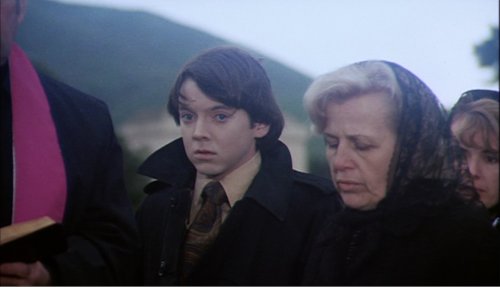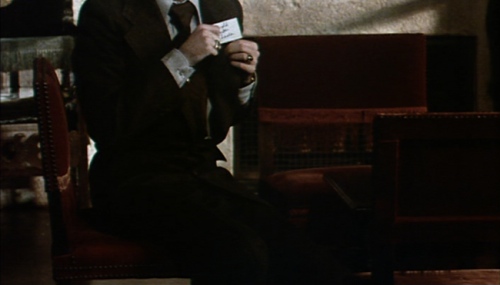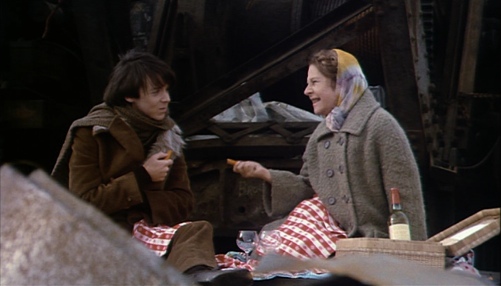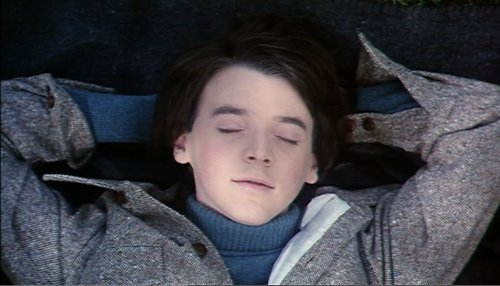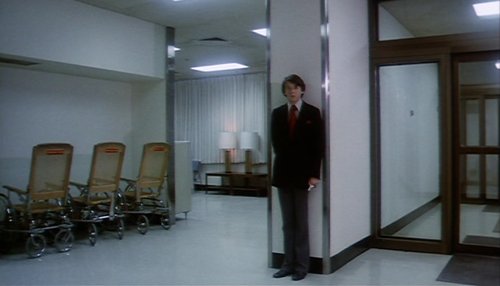|
Harold and MaudeHarold and Maude (Ashby, 1971) Spoiler Warning: The following essay discusses plot points and may "spoil" the experience for some readers. If, however, you want to decide whether this movie is or is not worth watching, everything above the black line is spoiler-free. Here's the good news, and bad news, about being nineteen: it doesn't last very long. For Harold Chasen (Bud Cort), though, every moment is agony. The son of a wealthy widow, imprisoned by his mother's demands and society's expectations, Harold's only escape is through death. Not actual death––not yet––but a series of staged suicide attempts, designed to shock and wound his mother. But it doesn't stop there. Harold drives a hearse, wears sombre clothes, visits funerals and junk wrecking sites. He has no friends to speak of. His uncle can, with a word from his mother, send him into the army. Things are not looking up for him, however many millions his family has salted away. Enter Dame Audrey Chardin, alias Maude, a vivacious septuagenarian. Harold and Maude could not be more different: their living spaces, clothes, philosophies and automobiles differ greatly from one another. Nonetheless, some similarity attracts each to the other, leading to a beautiful friendship––and something more. When Harold and Maude first came out, it was received––if it was known at all––as an anti-war comedy. The beauty of this movie is, it has so many layers, with every analysis an entirely different movie emerges. "Big issues" are constantly addressed, mentioned and hinted at throughout the film. Death, life, war, sex, parenthood, adolescence...need I go on? This analysis is restricted to fashion, but I'll touch on those issues throughout this essay. Let's start by examining each character's fashion choices in depth, and then survey the stylistic evolution of the film's characters through the film. Mrs. Chasen
Mrs. Chasen: The Computer Dating Service offers you at least three dates on the initial investment. They screen out the fat and ugly, so it is obviously a firm of high standards. Mrs. Chasen is a rich widow, and her days are given over to socializing and superficial, societally correct activities. She interprets Harold's despair, and suicide attempts, as childish and annoying, which only worsens the problem. In one scene, Mrs. Chasen even tells Harold to "eat up your beets," in front of a group of dinner guests. What could be more humiliating to a nineteen-year-old male? Harold's mother is this story's villain. According to Jungian archetype theory, Mrs. Chasen represents the world of the dead, as well as "anything that devours, seduces and poisons." Rather than accepting or welcoming Harold as he is, she strives to turn him into what he "should" be. At the story's outset she seems an all-encompassing presence, which Harold has neither the power nor the courage to escape from. Chasen's hair is cut in a severe, bang-less brown bob. Her hair is usually pulled away from her face, encircled by a large braid, pinned up or concealed under a large hat. Mrs. Chasen only wears brown, black, grey and white through the entire movie. We never see her in pants, and her skirts are almost always pencil skirts with no flare and no color. They never come above the knee, or very much below it; her blouses have long sleeves and high collars. She also wears stockings. In the late 60s/early 70s, this look was out of fashion, especially with young people, who preferred a more relaxed, colorful look––especially in the Bay Area, where Harold and Maude was shot. Put into so many words, Mrs. Chasen's philosophy is that one should wile away the hours in as pleasant a manner as possible, while conforming to the accepted societal norms. Despite this drab color scheme, Mrs. Chasen usually wears metal jewelry––an allusion to her wealth and status-seeking, perhaps. In the last scene, Mrs. Chasen is wearing a long, flowing white dress with an empire waist. Her hair is down and she's not wearing much makeup. Does this suggest her innocence? Her essential goodness? Maybe it makes her look like a goddess, and only highlights Harold's triumph over her. But that's for the Jungians to decide, and I'm not a Jungian. The Authority FiguresHarold does not just have to contend with his overbearing mother. The state, church and hosptial system all seek, in ways subtle and obvious, to constrain his personality and force him into some mold. The State
Uncle Victor: Call me "sir," Harold. First thing you learn in the Army––an officer deserves your respect. If Harold disobeys his mother too flagrantly, she can always threaten to send him into the army, and thus into war. His uncle Victor is a General in the U.S. Army, who can presumably send Harold to Vietnam at his (i.e., his sister(-in-law)'s) whim. Victor wears the ceremonial uniform of a US army general. His jacket front is studded with medals and four rows of thin military ribbons. In the US, these ribbons are awarded for services and accomplishments in the armed forces, including overseas service, combat action, serving in a certain campaign or war, or completing training in some discipline. Because Victor lost his right arm, his uniform comes with a string that will pull up his right sleeve into a salute. This detail, played for comedy, emphasizes Victor's buffoonery and symbolizes the costs of war, both physical and spiritual. It's also a joke––Victor "was General Macarthur's right-hand man," but he lost his right arm––and, somewhere along the way, his ability to think. In a later scene, Victor and Harold are driving through a park––or, I should say, being driven by a black chauffeur. When Victor says "the army takes care of you," we cut to a shot of the chauffeur, staring pensively at the road ahead. This chauffeur only has two rows of military ribbons; he also looks younger. Later we see him driving the car at a crawl behind Victor and Harold, as they walk through the park. If the army "takes care of you," at whose expense does it do that?
The Police are another element of state power. In this movie, the police wear all black, from their shoes to their ties to their hats. In 1971, wearing all black would have been weird, especially in California; it's so weird that even death-obsessed Harold doesn't do it. As Maude says: I'll never understand this mania for black. I mean no one sends black flowers, do they? Black flowers are dead flowers. Who sends black flowers to a funeral? It's absurd!A wound-up motorcycle cop, played by Tom Skerritt, looks like a Village Person to modern eyes: his black boots, tight black jeans, leather jacket, helmet and mustache are almost too much to be believed. Once again, the authority figures come across as buffoons, who have literally become "not themselves" to fit some social role. "That's the curse of a government job," Maude tells the motorcycle cop. It certainly is. The ChurchIn a scene left on the cutting room floor, Maude takes a felt pen from Harold's breast pocket and draws a cheery smile on the painting of the Virgin Mary and four statues of the saints. The priest reacts with blustering indignation, as he seems to react to everything. Religion's influence is mainly felt in the shots taken in funerals, cemeteries and churches. The priest wears a black cassock with a clerical collar. In one scene he wears a black boonie hat. The funeral attendees are all dressed in black. In one memorable scene, Maude breaks out a yellow umbrella in a see of black umbrellas employed by the other funeral attendees. In this film, black clothing symbolizes death, sadness and, to a certain extent, conformity. Religion is just another facet of this. The Hospital
Psychiatrist: That's very interesting, Harold, and I think, very illuminating. There seems to be a definite pattern emerging. And, of course, this pattern, once isolated, can be coped with. Recognize the problem, and you are halfway on the road to its, uh, its solution. Uh, tell me, Harold, what do you do for fun? What activity gives you a different sense of enjoyment from the others? Uh, what do you find fulfilling? What gives you that... special satisfaction? Harold's psychiatrist wears a navy blue, double-breasted blazer, dark grey pants, black oxfords and socks, a beige shirt, and a cream-colored tie with blue stripes. His left breast pocket has a white handkerchief. Harold and this psychiatrist wear this exact same outfit in all of their scenes together. Like the general's saluting sleeve, this visual joke also comments on Harold's passivity and how Harold and the psychiatrist may project themselves onto each other. In the penultimate scene of the film, when Harold is trying to communicate the urgency of the situation to the hospital staff, they are wearing all white, including little white hats. One nurse wears a brown apron over her dress. The doctor, who tells Harold the news, is wearing a white coat over a red shirt and black pants––similar to what Harold wears in this scene. The Computer DatesLike the three facets of authority, Harold's three computer dates represent three different species of mediocrity. Candy Gulf
Anyone who's gone to university will recognize Candy Gulf's "personality type" at once. In the Harold and Maude screeenplay, screenwriter Colin Higgins describes Candy as a "cute, blond [sic], typical American coed." In the movie she's a brunette, but the concept is the same. Candy's sweet, bubbly, a few molecules smarter than average, and otherwise forgettable. Candy's entire outfit is in different shades of purple, save for her stockings, which appear to be dark brown. Her skirt comes down from her waist to her mid-calves and is made out of felt, wool or some other coarse fabric. In lieu of a bra, Candy wears a large belt with a fruit bowl (?) insignia on the front. Her shirt is long-sleeved, in a light lavender fabric with a cross pattern embroidered onto it. She's also wearing some kind of choker necklace, made out of beads wired together in a fishnet pattern. I'm not sure if it's fair to judge from present-day fashion standards, but Candy Gulf's outfit strikes me as an early-1970s equivalent to the "knit hat" character in romantic comedies: that is, a "quirky" or "kooky" person whose contrived individuality is expressed by some mildly noncomformist flourish––such as, say, a knit hat. In this movie, Gulf's "quirkiness" is poked fun at, especially when she describes her brother's "cut-up" antics. Edith Fern
Edith is a file clerk for "Harrison Feed and Grain," which is about as exciting as it sounds. She's dressed in a sheer, white blouse with light blue stripes, with a blue, knee-length dress over it, green tights and dark green (or brown?) leather flats. Her hair is dyed red, and in a short mullet, which is very unflattering to her long face. In the script, Higgins describes Fern as "short, mousy and looks like a female Don Knotts." I was ready to deny this; then I saw a photograph of Don Knotts. There is a resemblance. I'm not sure what Edith represents; blandness, maybe? Her life is not very interesting, she is not very interesting, and her social role is insignificant. She's dressed like a schoolmarm in the making, not a young girl of about twenty. Sunshine Doré
We now come to Sunshine Doré, the "third and final computer date." Ms. Doré is an actress, and not a very good one. Her get-up is so bizarre I have to go through it item by item: 1. The hat. This is a variant of the Gatsby hat (or a newsboy cap), made out of leather (or pleather) and dyed beige. Her very long hair is pulled up into her cap. 2. The...necklace? It's some kind of leather neckpiece which extends down Ms. Doré's chest, with blue fabric cutaways. Whatever it is, it's quite ugly. 3. Sunshine's shirt. It's in a repeating white, purple, baby blue, brown and gray pattern. These horizontal lines contrast rather horribly with the following item: 4. Very tight gray pants with horizontal stripes in a lighter shade of gray. 5. White, knee-high boots with dark wooden heels. Like Candy Gulf, Ms. Doré is expressing an individuality, but it's not a particularly interesting one. Everything in her outfit clashes with everything else; and all the elements don't look that good, individually, either. What kind of statement is she trying to make? She's pretentious, flighty and attached, on some level, to the status quo ("I do so like the military, don't you?"). One rarely meets this type of person anymore, even among the old. This generation's aspiring actresses may care about "their instrument," but their concern is purely egoistic and remunerative ("If I don't lose ten pounds I'll never get this modelling job!"), and they would almost certainly not use "theater talk." Economic pressures have also squeezed much of the pretension out of young people, at least stateside; it's hard to worry about the development of your instrument and the state of your checking account at the same time.
Maude
Maude: Vice, Virtue. It's best not to be too moral. You cheat yourself out of too much life. Aim above morality. If you apply that to life, then you're bound to live it fully.Maude is the catalyst for the unfolding of the rest of the plot. A vivacious septuagenarian, Maude's outfits are loose, flowing and colorfully patterned, reflecting her philosophy on life. Maude (played by Ruth Gordon) emphasizes her legs by wearing short skirts (for her age) and dark tights with flat shoes. By 21st century standards, her outfits are "modest," only really showing her hands and the shape of her calves. Outside, she often wears a colorful scarves with yellow, white and pink patterns on them. This, combined with her light brown trench coat, allow her to express her individuality without being hassled by the police or other authority figures.
Like Mrs. Chasen, Maude wears her hair up in a braid around her head, now called a "Yulia" after Yulia Tymoshenko. It's a fetching look––girlish but still appropriate for her age. Her apartment is filled with odd things, assorted collectables, inventions, musical instruments and paintings. Her wardrobe reflects this lively disorder. Maude's outfit is colorful, but the colors themselves are subdued. Throughout the movie, Maude wears dark velvet, brown, black, forest green, browns and burgundies. Her color comes from accents: scarves, umbrellas and the occasional raincoat, daisy and hairpiece. In Maude's last scene, she's wearing a light pinkish-orange dress and vest combination. She and Harold finally free...though in very different ways, as Harold learns. Harold
Harold: I haven't lived. I've died a few times. Harold is about nineteen or twenty years old. His main sources of fun are going to funerals and staging fake suicides in front of his mother. His family is wealthy, but his mother controls the purse strings, and everything else. She still treats him like a child, and he's still too childish to assert his independence any other way. Harold goes through three distinct phases of dress as his character transitions through three distinct phases. For the purposes of this essay, I will categorize these phases as death, growth and rebirth. Death
In the movie's first arc, Harold dresses like a rich, middle-aged businessman––perhaps like his father dressed. Big ties, black coats, cream- and beige-colored dress shirts are all staples of his wardrobe, even when he's relaxing in his car. Even when he's "drowning" in his mother's pool. Harold dresses like he's going to a funeral, which fits because he is. His real self is trapped beneath the weight of societal expectations; he's trapped in a generic suit. During this arc, Harold's facial expression vacillates between suppressed rage and anxious introspection. His body language is stiff and awkward; he slumps forward protectively, or sits/stands up straight as a board. Growth
After he meets Maude, Harold's wardrobe undergoes a gradual change to more casual and less constricting fabrics. In their first outing, he's wearing a light brown corduroy suit and grey-green scarf over a dark brown turtleneck––the most casual outfit we've seen him in so far. During this arc, Harold still wears suits when around his mother. When not, he switches to casual leisure suits, including a greyish-pink suit and a black sweater with a pink shirt beneath it. The corpsepaint is not as intense in these scenes, and the added pink and light brown accents bring out the color in the actor's face. Harold's facial expressions change most rapidly in this sequence. First, he expresses shock and bewilderment at Maude's existence, combined with intrigue and desire. A kind of happily embarrassed flush comes over his face at certain junctures; so does a flirty smirk. Harold's outfits lighten progressively through this arc of the movie; in the scene with Uncle Victor at the Sutro Baths, Harold wears a white overcoat. Rebirth
Harold shakes off his mother and his Uncle Victor; for the first time in his life, he is truly happy and truly free. Here he wears turtlenecks and corduroy pants, even in front of his mother; it's only for his encounter with Sunshine Doré that Harold dons the business suit again. Now his wardrobe is full of light blues, dark browns and greys. He even wears a leather jacket. His face is flushed with color; at last, he looks like a well-adjusted, twenty-something male. Harold's body language is open and relaxed, like the top buttons of his shirt. Gone are the huge ties and the overstuffed jackets. He looks, well, like he's in love. A condensed version of this evolution plays out in the movie's last scenes. Harold has dressed up for Maude's birthday party in an elegant three-piece suit.
At the hospital, he sheds his coat and tie, but is still in a state of "limbo," waiting to hear the news. Once he does, he drives to Mori Point in a dreamlike state. We see the car go off the cliff...and see Harold standing above it, the wind blowing in his hair, holding a banjo, free to love and love some more.
ConclusionsThe emotional power of Harold and Maude comes from the sum of its parts. Good writing, great acting and excellent editing all play a role, not to mention the iconic soundtrack by Cat Stevens. Director Hal Ashby went on to make other great films such as The Landlord and Being There; his tutelage as an editor clearly served him well. This movie is also powerful because it speaks to so many universal themes. It's unblemished by cynicism or insincerity. Whether you're 18 or 80, you can find something, and someone, to identify with and relate to. But there's something beyond this, some ineffable quality, which makes it a classic. Its life affirming message? That's part of it. Beautiful cinematography? That's essential, but not integral. The setting? The architecture? The final scene? Yes, yes and yes...but there's some unknown factor which makes it so great. I won't even attempt to define it. What moral you draw from the story is up to you. I would conclude that life is meant to be enjoyed, and one must avoid boring people, whenever and however possible. Related Reading: Return to Enjoy Your Style's style in film page. Return to Enjoy Your Style's home page. Not what you're looking for? Find it, below: |
Search this site:





